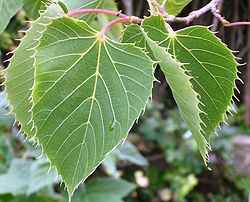| Henry's lime | |
|---|---|
 | |
| Leaves of Henry's lime in midsummer | |
| Scientific classification | |
| Kingdom: | Plantae |
| Clade: | Tracheophytes |
| Clade: | Angiosperms |
| Clade: | Eudicots |
| Clade: | Rosids |
| Order: | Malvales |
| Family: | Malvaceae |
| Genus: | Tilia |
| Species: | T. henryana |
| Binomial name | |
| Tilia henryana | |
Tilia henryana Szyszyl. , commonly known as Henry's lime, is a species of tree native to the Chinese provinces of Anhui, Henan, Hubei, Hunan, Jiangsu, Jiangxi, Shaanxi, and Zhejiang. [1] It was introduced to the West by Ernest Wilson in 1901, and is named after the Irish plantsman and sinologist Augustine Henry, who collected the type specimen in 1888.
